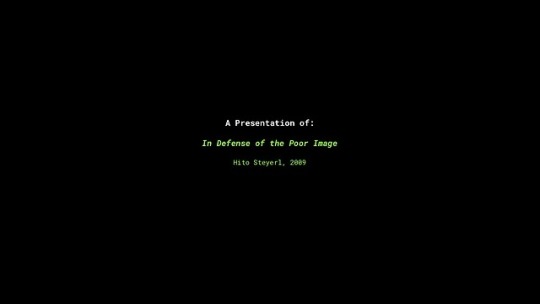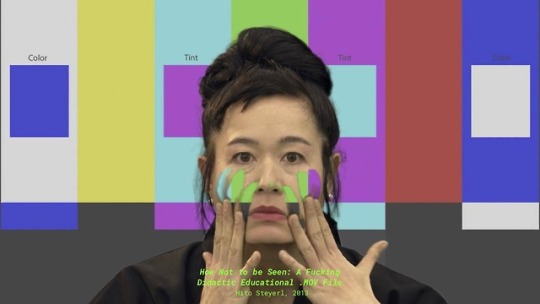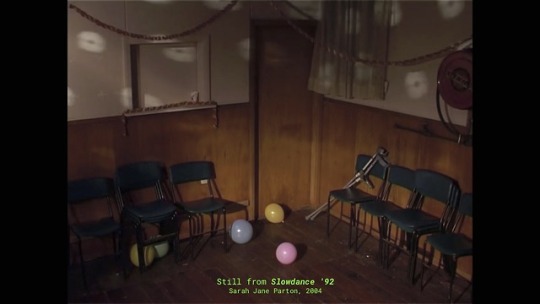#v; the conjunction of the spheres (free universe)
Explore tagged Tumblr posts
Text

RANDOM DIALOGUE // accepting // @filedfangs sent — 💬

“What do you remember about your mother?”
18 notes
·
View notes
Photo




Slides from my presentation. I wanted to represent my visual understanding of Steyerl’s essay In Defence of the Poor Image. The transcript/notes is as follows: I’m going to be presenting Hito Steyerl’s essay, ‘In Defense of the Poor Image’, published on e-flux in 2009. Who is Hito Steyerl? Born in 1966 in Munich, Hito Steyerl is an artist working with research and narrative driven filmmaking, installation works (image 2), and writer of prominent art essay texts/critiques. Steyerl also lectures New Media Art at University of the Arts, Berlin. (image 3) Last year, Steyerl became the first female to take number one position in ArtReview’s Power 100 list. Steyerl is a female artist with major influence who centers her work towards politics of computers and hypermodern technology in society, which brings us to ‘In Defense of the Poor Image’. (image 4) This is a still of television glitches from Shutterstock, representing a poor image at its most basic form. Published in online media, ‘In Defense’ is a commentary on the idolisation and use of images, which has arisen in the 21st century. Its critique is highly relevant as we view our online consumption in new perspectives.Steyerl leads the essay with an extended description of the term ‘poor image’. (image 5) A poor image is “a ghost of an image… distributed for free… compressed, reproduced, ripped, remixed, as well as copied and pasted”. Such as one of Thomas Ruffs jpeg series, where he deliberately is ruining already poor imagery. These images circulate and populate our visual experiences onlines, puncturing the sublime Instagram experience and festering in any Google Image search. Steyerl places them rock-bottom in the “class society of appearances, ranked and valued according to its resolution.” Post its introduction, ‘In Defense of the Poor Image’ breaks into 6 chapters, categorising poor images, their functions, applications, and societal impacts and reasonings for their existence. The first chapter, “Low Resolutions”, offers that images which are in focus, perfectly sharp and legible, are superior to those fuzzy and incomprehensible. Steyerl draws links from the ideal of the cinematic view - (image 6) utter perfection, “more mimetic and magic, more scary and seductive” than an experience of poor images. (This hyperreal Avengers poster is a representation of the cinematic view which dominated over poor images.) The following chapter, “Resurrection (as Poor Images)”, discusses the commercialisation of quality imagery and the subsequent exclusion of poor images. This exclusion applied to images that were “deemed too marginal to be broadcast on television”. In conjunction with experimental films and video essays, which were solely seen in special broadcastings at metropolitan film clubs, these images slipped away after a single screening, buried in a world of lesser than standard work. Steyerl then places reasons for a birth of “culture as a commodity”; the consumption of media was being impacted by monopolies and monetary drive towards the cinema, including control over “audiovisual in certain countries or territories.” (image 7) As a result - excluded imagery and its makers began to find various publicly accessible channels to position themselves on, even where they may not be curated or relevant to their intention. Sarah Jane Parton’s work can be seen on the online NZ archive Circuit - where it would have been otherwise unavailable for public consumption. Restriction of viewing has resulted in ‘leaked footage’, illegal recordings, and ‘rips’ of certain media, placing avant-garde and non-commercial cinema in the public sphere of the Internet - circulating now as poor images. Steyerl moves to “Privatization and Privacy”. She attests that poor images are being enabled to circulate with a larger frequency due to the “neoliberal restructuring of media production” and the demand for free, easily accessible media that is otherwise restricted by certain state laws and online rights. Disorganized privatisation, attributable to regional turmoil, leads to copies of precious materials being leaked, and transitioning through the world now as poor images. (image/video 9) Because “production of culture was considered a task of the state” but has since been vacuumed into a trillion dollar enterprise, poor images encourage piracy and media thievery. It’s too expensive for the average consumer to consider heading to the movies - why not pirate instead, in the comfort of your own home? Chapter #4, “Imperfect Cinema”. Steyerl begins this chapter by referencing a 1960s manifesto by Julio García Espinosa, For an Imperfect Cinema. She paraphrases that an ‘imperfect cinema’ “merges art with life and science, blurring the distinction between consumer and producer, audience and author.” Thus, an image or moving image that offers an alternative to the idealized ‘perfect image’, offers “an art of the people”. In regards to its visuality, it shares likeness with the poor image - often hurried, blurry, made by a dilettante or admirer of the arts. (image 10 neistat) While this opportunity is certainly appreciated and operated within, by being part of the world of poor images it opens itself up to a multitude of negative operations - “hate speech, spam, and other rubbish make their way through digital connections”. Steyerl iterates further by claiming that poor images are therefore the most desired images, on trend, fashionable, and enjoyed. (This is an image from Casey Neistats vlog protesting inhibited bike lanes in NYC) If we are to look at poor images as a whole, they make up a representation of the condition of the population who consumes them - and they certainly are being consumed through editing, remixing, reformatting, and simply spreading them into virality. We move to chapter #5, “Comrade, what is your visual bond today?”. (image/video 111) Unquestionably there is strong visual and cultural bonding in online consumption; the colloquial term for it is a “meme”, a poor image circulated which “reconnects dispersed worldwide audiences.” Steyerl positions meme culture as an opening for cross-cultural debate, utilizing globalisation and the power of the internet. (This video shot to worldwide memedom from 2007 when it was used in place of intended images or videos, pranking the receiver, garnering the term being “Rick-rolled”) Steyerl references “visual bonds”, a term from Soviet film director Dziga Vertov. Vertov imagined that popular imagery could create a type of community which could “not only inform or entertain, but also organize its viewers.” (image 12) We can recognize this statement when applied to multitudes of social media and its events, gatherings and so-called ‘organisations’ for a subculture of visual bonds AKA memes (These are real life events organised on Facebook where people can share interests together) (image 13) In her concluding section, “Now!”, Steyerl finalizes the text with ambiguous comments regarding the life of poor images. Poor images can easily be seen as an everyday encounter in the world of online consumption. They extend beyond our Internet interactions, reaching into personal relationships, resurfacing for that birthday post to your friends. Steyerl positions them as an important creation within a world filled with images, stating that the poor image is “about defiance and appropriation just as it is about conformism and exploitation. In short: it is about reality”. Biblio https://rcpp.lensbased.net/meta/http://www.e-flux.com/program/65176/hito-steyerl/Images(2)https://www.artforum.com/video/hito-steyerl-how-not-to-be-seen-a-fucking-didactic-educational-mov-file-2013-51651(3) http://artviewer.org/hito-steyerl-at-kunsthal-charlottenborg/(4)https://www.shutterstock.com/video/clip-22028014-stock-footage-interference-glitches-poor-quality-reception-of-digital-channels-on-the-lcd-display.html?src=rel/8910844:8/gg(5) https://www.metalocus.es/en/news/thomas-ruff-mars(6) http://www.4usky.com/movie-wallpapers.html(7) https://www.circuit.org.nz/film/slowdance-92(8)https://www.youtube.com/watch?v=pS_Z2kSFadU (10)https://www.youtube.com/watch?v=bzE-IMaegzQ (11)https://www.youtube.com/watch?v=dQw4w9WgXcQ (12)https://www.facebook.com/events/763691600489706/ https://www.facebook.com/events/1627065397343772/?active_tab=about https://www.facebook.com/events/398897497228159/(13) http://www.kesselskramer.com/exhibitions/24-hrs-of-photos
0 notes
Text
little thing for @alreadybrcken
From this angle, she’s mostly just a mess of black hair under a big pile of furs. A small noise from the pile sounds like being even one-quarter awake is the absolute worst. “Come back when the sun’s high.” Not that she has a clue what time it is. The pile groans. “Or better yet, don’t.”

14 notes
·
View notes
Text
a short starter for @alreadybrcken from (x) 🐱

“What does it look like I’m doing? I’m hiring a Witcher.” With all the grace and charm befitting the undignified task, which is to say, almost none.
12 notes
·
View notes
Text

400 DIALOGUE PROMPTS // accepting // @betterxvillain sent — "i need you to trust me."

“And as a sign of that trust, I need to invite you in?” Convenient, her tone seems to say. But Yennefer is confident in her capabilities. It wouldn’t do to seem concerned of what he might do against how she’d retaliate, blood-sucking creature or not. Despite fighting monsters not being her specialty. Could easily be her arrogance talking. “Fine. A word of advice, though— stay out of my head, I’ll stay out of yours.” She glances over him as if to pause for dramatic effect. “You may come in.”
2 notes
·
View notes
Text

TERRIBLE MEETINGS // accepting // @betterxvillain sent — “I promise you, this isn’t what it looks like.”
The sight might frighten most people, but Yennefer merely interlaces her fingers in front of her and stands taller. “All right. You don’t look like a butcher, but I’m sure there’s a perfectly innocent reason a person needs all that blood. Let’s hear it.” Necromancy, she suspects. At best, he’s a dumb civilian dabbling in black magic for whatever reason. At worst... the possibilities begin to widen.

#betterxvillain#( hope this works lmk if not! )#( going with witcher verse )#v; the conjunction of the spheres (free universe)#answered;#ask meme;
5 notes
·
View notes
Text
@gwynblcidd liked for a short starter

“Did you at least get a good price for all this trouble?”
6 notes
·
View notes
Text
little thing for @gwynblcidd
“Geralt,” her voice is abnormally soft with sleep, but there’s something ill and wrong about it. She wrinkles her nose, presumably at the horrible stale smell of beer still lingering in undrunk cups. “That ale is as shit the next day as it was going down.” A small whirl of her fingers— feels so unreasonably draining— and every drop of offending liquid escorts itself out the window, which promptly closes on the almost equally offensive sun.

#( no worries about slow dear take your time! <3 )#gwynblcidd#v; the conjunction of the spheres (free universe)
2 notes
·
View notes
Note
♡
{ Detailed Pre-Established Relationship Meme } — @alreadybrcken Send me a ♡ and I’ll bold what I want to see with our muses and italicize things I may be open to! (send “heart!” if the symbol is unavailable)
I want our muses to be: friends | ex-friends | rivals | rivals with sexual/romantic tension | enemies | enemies with sexual/romantic tension | lovers | ex-lovers | partners/coworkers | pen pals/internet friends | friends with benefits | soulmates
Our muses met: as children | as teenagers | as adults | just recently
(for romance) Our muses’ relationship is: still exciting and lively | stable | starting to feel awkward | in jeopardy | romantic, but the sexual attraction is fading | sexual, but the romantic attraction is fading | toxic and self-destructive | unrequited, with my muse pining after yours | unrequited, with your muse pining after mine | determined by fate
(for rivals) Our muses’ relationship is: awkward | fiery | friendly | petty | mostly for show | losing its spark | starting to develop into something more | one-sided, with my muse considering yours a rival | one-sided, with your muse considering mine a rival | determined by fate
(for enemies) Our muses’ relationship is: dangerous to themselves | dangerous to others | based on family matters | based on professional matters | based on lies/misunderstandings | unpredictable | passionate | nothing personal at first, but changes with time | determined by fate
(for friends) Our muses’ relationship is: stable | sickeningly sweet | the kind of close friendship that makes others jealous | falling apart | based on shared interests | based on circumstance (like school or work) | based on family ties | developing into something more (romantic/sexual) | developing into something more (antagonistic) | determined by fate
#( lots of possibilities )#( i can see them looping thru many dynamics )#alreadybrcken#( too soon to say on the romance side )#v; the conjunction of the spheres (free universe)#answered;#ask meme;
1 note
·
View note
Text

ALL ABOUT SCARS // accepting // @bardictales sent — “It’s not gonna scar, is it?“

“It will— the next time you trip and land on another man’s lady, and I’m not around. Or was it the lady herself this time?” She exhales with instant regret for asking. Her dry tone of judgement might be mistaken for an open door to his sex life. “Never mind, I don’t care.” Her hand hovers near the wound, a silent healing incantation filling her fingertips. She’s certainly not at all perturbed by his proclivities. Just, you know, his stupidity. Yennefer curbs the magic for a moment, though, wondering if she detected disappointment in his voice. “Unless you’d rather savor the memory?” She could leave him a scar, if he wishes.
0 notes